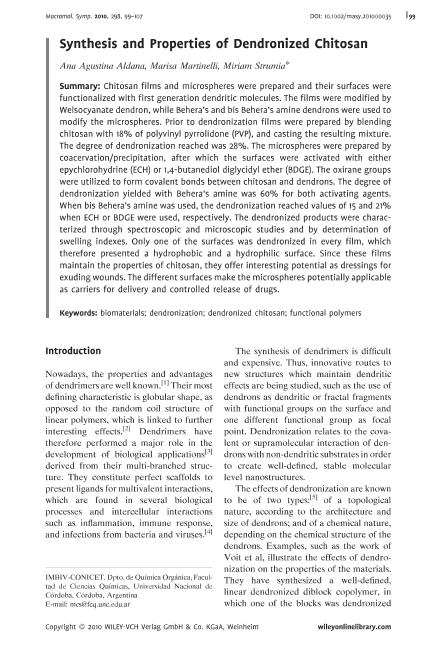Artículo
Synthesis and Properties of Dendronized Chitosan
Fecha de publicación:
12/2010
Editorial:
Wiley
Revista:
Macromolecular Symposia
ISSN:
1022-1360
e-ISSN:
1521-3900
Idioma:
Inglés
Tipo de recurso:
Artículo publicado
Clasificación temática:
Resumen
Chitosan films and microspheres were prepared and their surfaces were
functionalized with first generation dendritic molecules. The films were modified by
Weisocyanate dendron, while Behera?s and bis Behera?s amine dendrons were used to
modify the microspheres. Prior to dendronization films were prepared by blending
chitosan with 18% of polyvinyl pyrrolidone (PVP), and casting the resulting mixture.
The degree of dendronization reached was 28%. The microspheres were prepared by
coacervation/precipitation, after which the surfaces were activated with either
epychlorohydrine (ECH) or 1,4-butanediol diglycidyl ether (BDGE). The oxirane groups
were utilized to form covalent bonds between chitosan and dendrons. The degree of
dendronization yielded with Behera?s amine was 60% for both activating agents.
When bis Behera?s amine was used, the dendronization reached values of 15 and 21%
when ECH or BDGE were used, respectively. The dendronized products were characterized
through spectroscopic and microscopic studies and by determination of
swelling indexes. Only one of the surfaces was dendronized in every film, which
therefore presented a hydrophobic and a hydrophilic surface. Since these films
maintain the properties of chitosan, they offer interesting potential as dressings for
exuding wounds. The different surfaces make the microspheres potentially applicable
as carriers for delivery and controlled release of drugs.
Palabras clave:
Biomaterials
,
Dendronization
,
Dendronized Chitosan
,
Functional Polymers
Archivos asociados
Licencia
Identificadores
Colecciones
Articulos(IMBIV)
Articulos de INST.MULTIDISCIPL.DE BIOLOGIA VEGETAL (P)
Articulos de INST.MULTIDISCIPL.DE BIOLOGIA VEGETAL (P)
Citación
Aldana, Ana Agustina; Martinelli, Marisa; Strumia, Miriam Cristina; Synthesis and Properties of Dendronized Chitosan; Wiley; Macromolecular Symposia; 298; 1; 12-2010; 99-107
Compartir
Altmétricas




